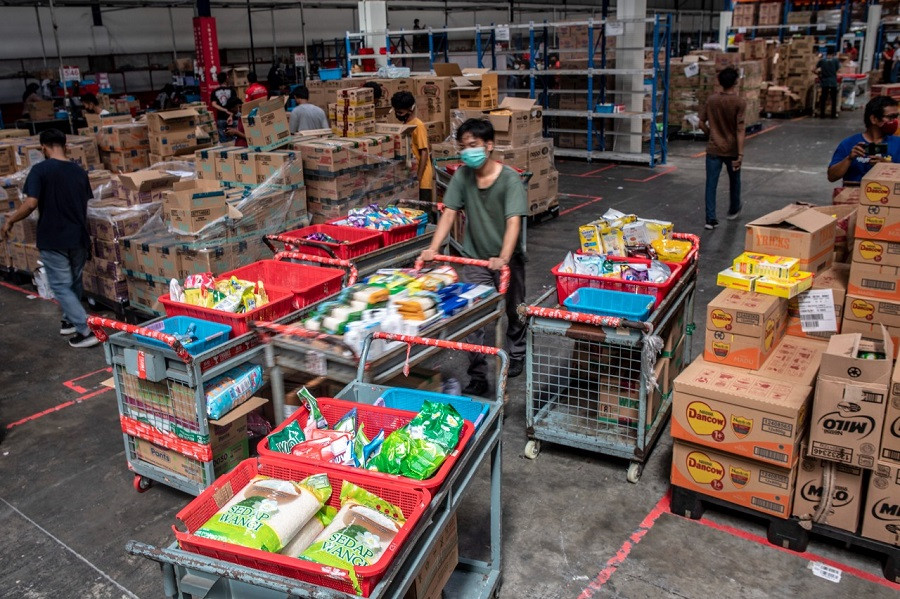Popular Reads
Top Results
Can't find what you're looking for?
View all search resultsPopular Reads
Top Results
Can't find what you're looking for?
View all search results3Ts to drive Southeast Asia’s economic growth
RCEP in particular, with its tariff reductions and business-friendly rules of origin, is increasing the appeal of Southeast Asia as a manufacturing base.
Change text size
Gift Premium Articles
to Anyone
E
ighteen months into a historic interest-rate upcycle, Southeast Asia’s economic prospects continue to stand out in a world faced with high inflation and soft demand. Three long-term trends will ensure that this dynamic region remains the growth engine of the world.
Our latest forecast is for the six largest economies in Southeast Asia to grow by 4.2 percent this year and 4.8 percent next year, far outstripping the expansion expected in the developed world (1.1 percent in 2023 and 0.7 percent in 2024).
This is all the more remarkable given tourism dollars have not flowed from China to Southeast Asia as anticipated. For example, in Singapore and Thailand – two popular destinations for Chinese holidaymakers – tourist arrivals from China are only at about one-third of pre-covid levels.
A recovery in tourism is certainly a welcome boon for Southeast Asia. At the same time, three long-term trends – trade, transition to net zero, and digital transformation – will power the region’s economic growth for decades to come.
Southeast Asia has come a long way as a manufacturing dynamo. It now accounts for 8 percent of global exports and since 2020 has surpassed the European Union to become China’s largest trading partner.
The region is also benefiting from a restructuring of global supply chains as it sits at the crossroads of two of the world’s largest free trade agreements: the Regional Comprehensive Economic Partnership (RCEP) and the Comprehensive and Progressive Agreement for Trans-Pacific Partnership.
RCEP in particular, with its tariff reductions and business-friendly rules of origin, is increasing the appeal of Southeast Asia as a manufacturing base, a fact that more corporates are recognizing. A recent HSBC survey shows that over the next 12-24 months Asia-Pacific corporates will place 24.4 percent of their supply chains in Southeast Asia, up from 21.4 percent in 2020.
And as more companies diversify and adopt the “China+1” strategy, Southeast Asia will continue to gain market share. More global foreign direct investment will be directed towards the region as the center of gravity of global manufacturing continues to shift.
Transition to net zero is the second structural trend that is bringing tremendous opportunities as Southeast Asia races to “green its grid”.
Southeast Asia is among the world’s most at-risk regions when it comes to global warming in general and rising sea levels in particular. Yet to fuel the region’s development, demand for energy continues to grow rapidly.
Most of the energy powering Southeast Asia comes from fossil fuels, so it is pleasing that Indonesia and Vietnam – two of the region’s most dynamic economies as well as two of the world’s top coal-burning countries – have announced their respective Just Energy Transition Partnerships (JETP).
Under this new funding model, tens of billions of dollars in public and private finance will be mobilized, catalyzing the decarbonization of the countries’ power sectors and facilitating their energy transition.
Innovation in clean tech is also growing fast in Southeast Asia. Clean tech is at the cusp of exponential growth, and as with fintech, companies in the region have the opportunity to localize a global technology and scale it domestically. Investment and financial support will only help accelerate its development and adoption.
The third long-term cause for optimism is the digital transformation of the region’s economy.
Southeast Asia has a vibrant digital economy, worth nearly US$200 billion as of 2022 and expected to surpass $300 billion by 2025. Add an internet population of 460 million (out of a total population of 600 million), and companies are transforming their business models to cater to changing customer behavior.
Whereas pre-COVID e-commerce was only a nice-to-have, the pandemic has underscored the criticality of an online presence to a firm’s existence. The shift to D2C, or the direct-to-consumer business model, gives firms better control over sales, marketing and, crucially, customer data – which can not only provide real-time analyses but also generate accurate forecasts.
Underpinning this explosive growth of Southeast Asia’s digital economy is the proliferation of real-time payments in the region – Thailand is the world’s fourth-largest real-time payments market by volume, for instance (ACI Worldwide, 2023). While instantaneous payments can be sent and received domestically, the real prize lies in linking up the region’s various real-time payments systems.
When that becomes a reality, we can expect a jump in the velocity of transactions, whether they are business-to-business or business-to-consumer, which in turn will lead to greater economic activity in the region.
Nowhere is immune to the challenges facing the global economy. The rising cost of capital will only increase the scrutiny of every investment dollar, whether it is used for moving factories, decarbonizing supply chains, or digitizing operations.
But as an economic engine with favorable demographics, Southeast Asia is well positioned to capture the opportunities stemming from these three long-term trends. The region needs to continue to nurture and attract talent, and as an industry we shall continue to play our part in realizing Southeast Asia’s growth potential.
***
The writer is head of commercial banking, South and Southeast Asia, at HSBC.











